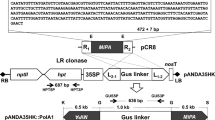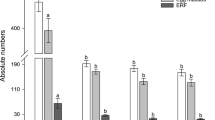Abstract
RNA interference (RNAi) techniques provide a major breakthrough in functional analysis for plant parasitic nematodes (PPNs). It offers the possibility of identifying new essential targets and consequently developing new resistance transgenes. To validate the potential of Mi-Rpn7 as a target for controlling root knot nematode Meloidogyne incognita and to evaluate the feasibility of our modified platform for assessing silencing phenotypes, we knocked down the Rpn7 gene of M. incognita using RNAi in vitro and in vivo. After soaking with 408-bp Rpn7 dsRNA, pre-parasitic second-stage juvenile (J2) nematodes showed specific transcript knockdown, resulting in an interrupted locomotion in an attraction assay with Pluronic gel medium, and consequently in a reduction of nematode infection ranging from 55.2% to 66.5%. With in vivo expression of Rpn7 dsRNA in transformed composite plants, the amount of egg mass per gram root tissue was reduced by 34% (P < 0.05) and the number of eggs per gram root tissue was reduced by 50.8% (P < 0.05). Our results demonstrated that the silencing of the Rpn7 gene in M. incognita J2s significantly reduced motility and infectivity. Although it does not confer complete resistance, Mi-Rpn7 RNAi in hairy roots produced significant negative impacts on reproduction and motility of M. incognita. In addition, the presented modified procedure provides technique reference for PPN genes functional analysis or target screening.





Similar content being viewed by others
References
Abad, P., Gouzy, J., Aury, J. M., et al. (2008). Genome sequence of the metazoan plant-parasitic nematode Meloidogyne incognita. Nature Biotechnology, 26, 909–915.
Alkharouf, N. W., Klink, V. P., & Matthews, B. F. (2007). Identification of Heterodera glycines (soybean cyst nematode [SCN]) cDNA sequences with high identity to those of Caenorhabditis elegans having lethal mutant or RNAi phenotypes. Experimental Parasitology, 115, 247–258.
Bakhetia, M., Charlton, W. L., Urwin, P. E., et al. (2005). RNA interference and plant parasitic nematodes. Trends in Plant Science, 10, 362–367.
Bakhetia, M., Urwin, P. E., & Atkinson, H. J. (2007). qPCR analysis and RNAi define pharyngeal gland cell-expressed genes of Heterodera glycines required for initial interactions with the host. Molecular Plant-Microbe Interactions, 20, 306–312.
Byrd, D. W., Kirkpatrick, T., & Barker, K. R. (1983). An improved technique for clearing and staining plant tissue for detection of nematodes. Journal of Nematology, 15, 142–143.
Cao, D., Hou, W. S., Song, S. K., et al. (2009). Assessment of conditions affecting Agrobacterium rhizogenes-mediated transformation of soybean. Plant Cell, Tissue and Organ Culture, 96, 45–52.
Charlton, W. L., Harel, H. Y., Bakhetia, M., et al. (2010). Additive effects of plant expressed double-stranded RNAs on root-knot nematode development. International Journal for Parasitology, 40, 855–864.
Chen, H., Nelson, R. S., & Sherwood, J. L. (1994). Enhanced recovery of transformants of Agrobacterium tumefaciens after freeze-thaw transformation and drug selection. Biotechniques, 16, 664–670.
Chen, Q., Rehman, S., Smant, G., et al. (2005). Functional analysis of pathogenicity proteins of the potato cyst nematode Globodera rostochiensis using RNAi. Molecular Plant-Microbe Interactions, 18, 621–625.
Chi-Ham, C. L., Clark, K. L., & Bennett, A. B. (2010). The intellectual property landscape for gene suppression technologies in plants. Nature Biotechnology, 28, 32–36.
Chitwood, D. J. (2003). Research on plant-parasitic nematode biology conducted by the United States Department of Agriculture-Agricultural Research Service. Pest Management Science, 59, 748–753.
Collier, R., Fuchs, B., Walter, N., et al. (2005). Ex vitro chimeric plants: an inexpensive, rapid method for root biology. The Plant Journal, 43, 449–457.
Dafny-Yelin, M., Chung, S. M., Frankman, E. L., et al. (2007). pSAT RNA interference vectors: a modular series for multiple gene down-regulation in plants. Plant Physiology, 45, 1272–1281.
Dalzell, J. J., McMaster, S., Johnston, M. J., et al. (2009). Non-nematode-derived double-stranded RNAs induce profound phenotypic changes in Meloidogyne incognita and Globodera pallida infective juveniles. International Journal for Parasitology, 39, 1503–1516.
Dubreuil, G., Magliano, M., Deleury, E., et al. (2007). Transcriptome analysis of root-knot nematode functions induced in the early stages of parasitism. New Phytologist, 176, 426–436.
Furner, I. J., Huffman, G. A., Amasino, R. M., et al. (1986). An Agrobacterium transformation in the evolution of the genus Nicotiana. Nature, 319, 422–427.
Haegeman, A., Vanholme, B., & Gheysen, G. (2009). Characterization of a putative endoxylanase in the migratory plant-parasitic nematode Radopholus similis. Molecular Plant Pathology, 10, 389–401.
Hershko, A., & Ciechanover, A. (1998). The ubiquitin system. Annual Review of Biochemistry, 67, 425–479.
Huang, G., Allen, R., Davis, E. L., et al. (2006). Engineering broad root-knot resistance in transgenic plants by RNAi silencing of a conserved and essential root-knot nematode parasitism gene. Proceedings of the National Academy of Sciences of the United States of America, 103, 14302–14306.
Ibrahim, H. M., Alkharouf, N. W., Meyer, S. L., et al. (2011). Post-transcriptional gene silencing of root-knot nematode in transformed soybean roots. Experimental Parasitology, 127, 90–99.
Jefferson, R. A., Kavanagh, T. A., & Bevan, M. W. (1987). GUS-fusions: β-glucuronidase as a sensitive and versatile gene fusion marker in higher plants. EMBO Journal, 6, 3901–3907.
Jian, B., Hou, W., Wu, C., Liu, B., Liu, W., Song, S., et al. (2009). Agrobacterium rhizogenes-mediated transformation of Superroot-derived Lotus corniculatus plants: a valuable tool for functional genomics. BMC Plant Biology, 9, 1–14.
Kamath, R. S., Fraser, A. G., Dong, Y., et al. (2003). Systemic functional analysis of the Caenorhabditis elegans genome using RNAi. Nature, 421, 231–237.
Kereszt, A., Li, D. X., Indrasumunar, A., et al. (2007). Testing gene function in transgenic soybean roots. Nature Protocols, 2, 948–952.
Klink, V. P., Kim, K. H., Martins, V., et al. (2009). A correlation between host-mediated expression of parasite genes as tandem inverted repeats and abrogation of development of female Heterodera glycines cyst formation during infection of Glycine max. Planta, 230, 53–71.
Lee, M. H., Yoon, E. S., Jeong, J. H., et al. (2004). Agrobacterium rhizogenes-mediated transformation of Taraxacum platy-carpum and changes of morphological characters. Plant Cell Reports, 22, 822–827.
Li, J., Todd, T. C., Oakley, T. R., et al. (2010a). Host-derived suppression of nematode reproductive and fitness genes decreases fecundity of Heterodera glycines Ichinohe. Planta, 232, 775–785.
Li, J., Todd, T. C., & Trick, H. N. (2010b). Rapid in planta evaluation of root expressed transgenes in chimeric soybean plants. Plant Cell Reports, 29, 113–123.
Lilley, C. J., Goodchild, S. A., Atkinson, H. J., et al. (2005). Cloning and characterization of a Heterodera glycines aminopeptidase cDNA. International Journal for Parasitology, 35, 1577–1585.
Lilley, C. J., Bakhetia, M., Charlton, W. L., et al. (2007). Recent progress in the development of RNA interference for plant parasitic nematodes. Molecular Plant Pathology, 8, 701–711.
Lindbo, J. A., & Dougherty, W. G. (2005). Plant pathology and RNAi: a brief history. Annual Review of Phytopathology, 43, 191–204.
Murray, M. G., & Thompson, W. F. (1980). Rapid isolation of high molecular weight plant DNA. Nucleic Acids Research, 8, 4321–4326.
Niu, J. H., Jian, H., Xu, J. M., et al. (2010). RNAi technology extends its reach: engineering plant resistance against harmful eukaryotes. African Journal of Biotechnology, 9, 7573–7582.
Park, J., Lee, K., Lee, S. J., et al. (2008). The efficiency of RNA interference in Bursaphelenchus xylophilus. Molecules and Cells, 26, 81–86.
Reynolds, A. M., Dutta, T. K., Curtis, R. H., et al. (2011). Chemotaxis can take plant-parasitic nematodes to the source of a chemo-attractant via the shortest possible routes. Journal of the Royal Society, Interface, 8, 568–577.
Rosso, M. N., Dubrana, M. P., Cimbolini, N., et al. (2005). Application of RNA interference to root-knot nematode genes encoding esophageal gland proteins. Molecular Plant-Microbe Interactions, 18, 615–620.
Rosso, M. N., Jones, J. T., & Abad, P. (2009). RNAi and functional genomics in plant parasitic nematodes. Annual Review of Phytopathology, 47, 207–232.
Rual, J. F., Ceron, J., Koreth, J., et al. (2004). Toward improving Caenorhabditis elegans phenome mapping with an ORFeome-based RNAi library. Genome Research, 14, 2162–2168.
Schwartz, A. L., & Ciechanover, A. (1999). The ubiquitin-proteasome pathway and pathogenesis of human diseases. Annual Review of Medicine, 50, 57–74.
Shingles, J., Lilley, C. J., Atkinson, H. J., et al. (2007). Meloidogyne incognita: molecular and biochemical characterization of a cathepsin L cysteine proteinase and the effect on parasitism following RNAi. Experimental Parasitology, 115, 114–120.
Sonnichsen, B., Koski, L. B., Walsh, A., et al. (2005). Full-genome RNAi profiling of early embryogenesis in Caenorhabditis elegans. Nature, 434, 462–469.
Steeves, R. M., Todd, T. C., Essig, J. S., et al. (2006). Transgenic soybeans expressing siRNAs specific to a major sperm protein gene suppress Heterodera glycines reproduction. Functional Plant Biology, 33, 991–999.
Takahashi, M., Iwasaki, H., Inoue, H., et al. (2002). Reverse genetic analysis of the Caenorhabditis elegans 26S proteasome subunits by RNA interference. Biological Chemistry, 383, 1263–1266.
Urwin, P. E., Lilley, C. J., & Atkinson, H. J. (2002). Ingestion of double-stranded RNA by preparasitic juvenile cyst nematodes leads to RNA interference. Molecular Plant-Microbe Interactions, 15, 747–752.
Wallace, H. R. (1968). The dynamics of nematode movement. Annual Review of Phytopathology, 6, 91–114.
Wang, C., Bruening, G., & Williamson, V. M. (2009a). Determination of preferred pH for root-knot nematode aggregation using pluronic F-127 gel. Journal of Chemical Ecology, 35, 1242–1251.
Wang, C., Lower, S., & Williamson, V. M. (2009b). Application of pluronic gel to the study of root-knot nematode behaviour. Nematology, 11, 453–464.
Wang, C., Lower, S., Thomas, V. P., et al. (2010). Root-knot nematodes exhibit strain-specific clumping behavior that is inherited as a simple genetic trait. PLoS ONE, 5, e15148.
Yadav, B. C., Veluthambi, K., & Subramaniam, K. (2006). Host-generated double stranded RNA induces RNAi in plant-parasitic nematodes and protects the host from infection. Molecular and Biochemical Parasitology, 148, 219–222.
Yelin, M. D., Chung, S. M., Frankman, E. L., & Tzfira, T. (2007). pSAT RNA interference vectors: a modular series for multiple gene down-regulation in plants. Plant Physiology, 145, 1272–1281.
Acknowledgments
The authors would like to thank Professors Tevi Tzfira and Dr. Peter M Gresshoff, the University of Queensland, Australia, for providing pSAT6 RNAi vector, pCAMBIA3301 vector and A. rhizogenes strain K599 kindly. This study was financially supported by Program for Changjiang Scholars and Innovative Research Team in University (IRT1042), and the Special Fund for Agro-scientific Research in the Public Interest, China (No. 20113018) and the National Foundation of Natural Sciences, China (No. 30971901), and project 948 from the Ministry of Agriculture of China (No. 2011-G4)
Author information
Authors and Affiliations
Corresponding author
Rights and permissions
About this article
Cite this article
Niu, J., Jian, H., Xu, J. et al. RNAi silencing of the Meloidogyne incognita Rpn7 gene reduces nematode parasitic success. Eur J Plant Pathol 134, 131–144 (2012). https://doi.org/10.1007/s10658-012-9971-y
Accepted:
Published:
Issue Date:
DOI: https://doi.org/10.1007/s10658-012-9971-y




